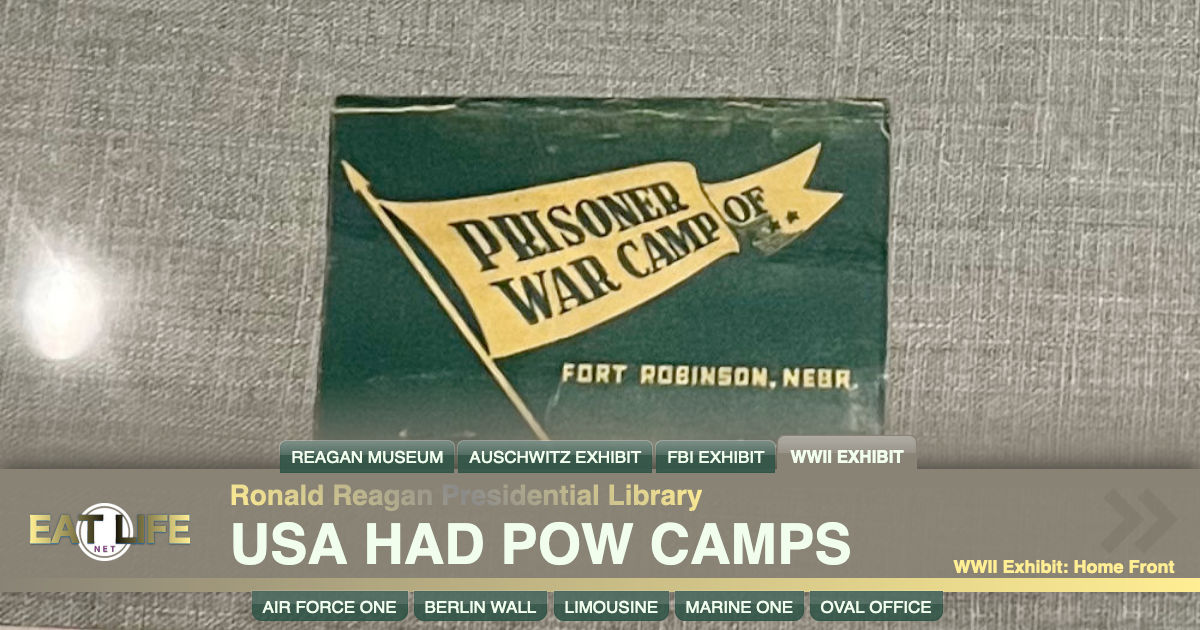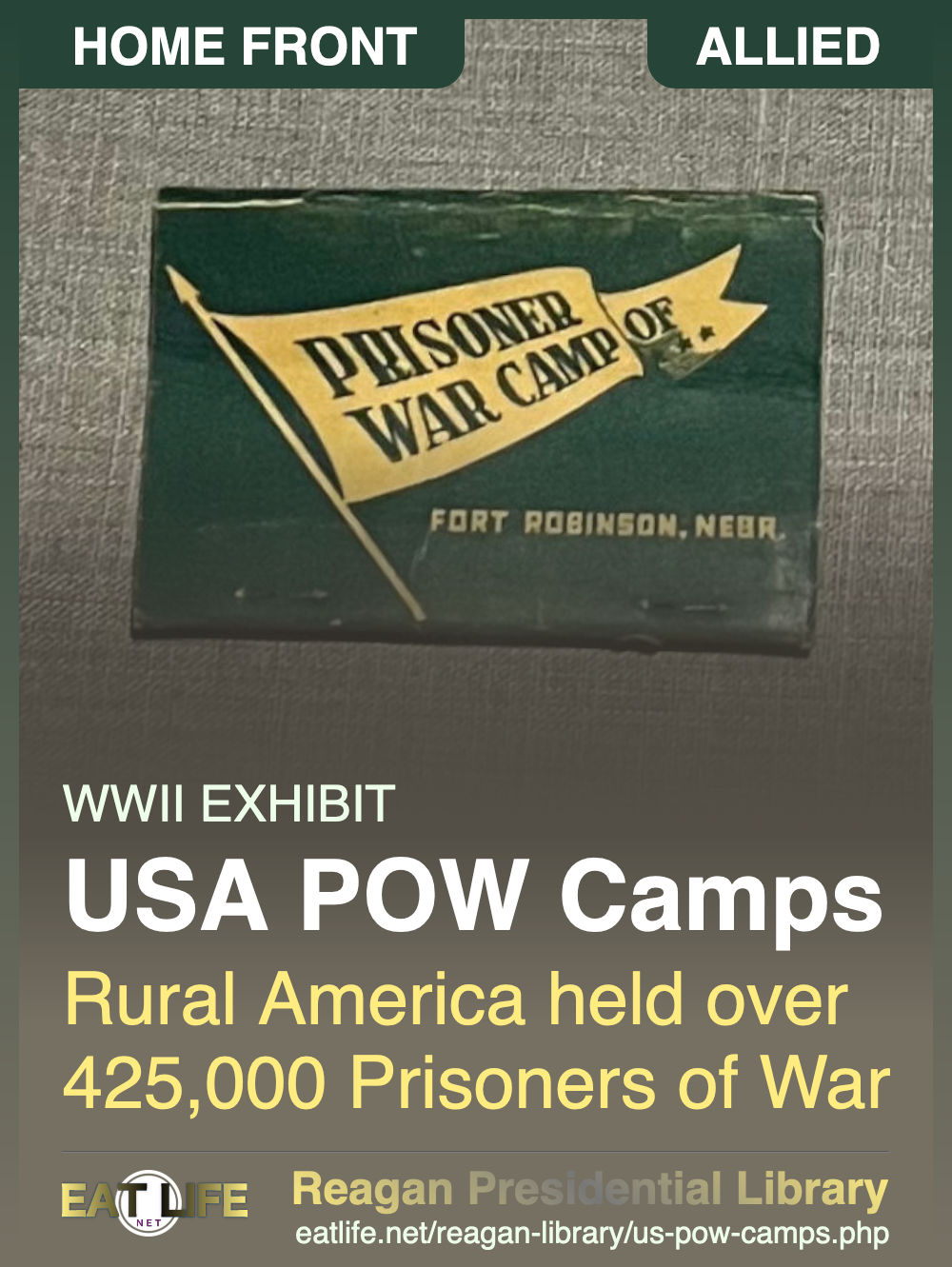- 371,683 Germans
- 50,273 Italians
- 3,915 Japanese
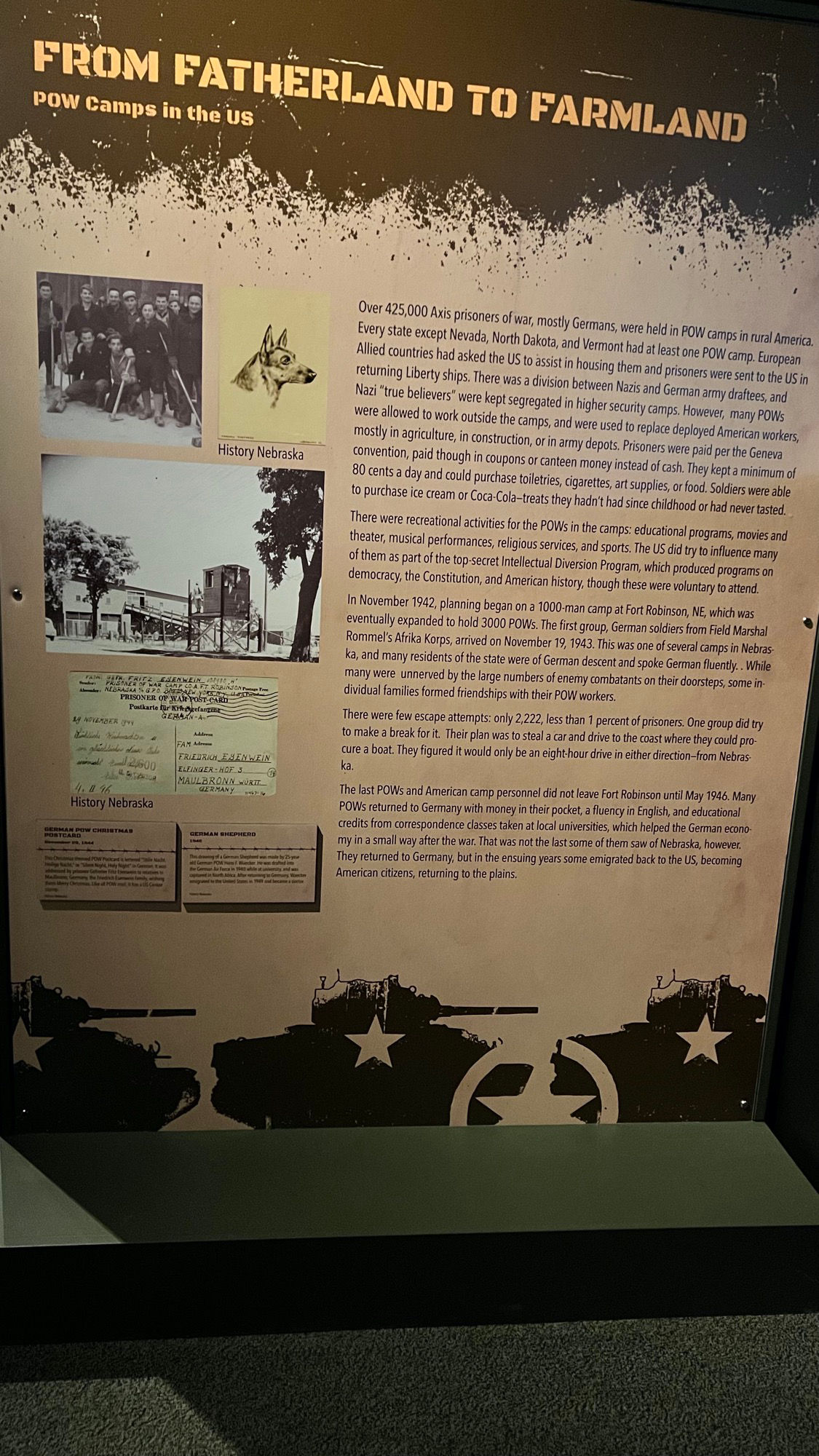
POW Camps in the US
Over 425,000 Axis prisoners of war, mostly Germans, were held in POW camps in rural America. Every state except Nevada, North Dakota, and Vermont had at least one POW camp.
European Allied countries had asked the US to assist in housing them and prisoners were sent to the US in returning Liberty ships. There was a division between Nazis and German army draftees, and Nazi "true believers" were kept segregated in higher security camps.
However, many POWs were allowed to work outside the camps, and were used to replace deployed American workers, mostly in agriculture, in construction, or in army depots. Prisoners were paid per the Geneva convention, paid though in coupons or canteen money instead of cash. They kept a minimum of 80 cents a day and could purchase toiletries, cigarettes, art supplies, or food. Soldiers were able to purchase ice cream or Coca-Cola - treats they hadn't had since childhood or had never tasted.
There were recreational activities for the POWs in the camps: educational programs, movies and theater, musical performances, religious services, and sports. The US did try to influence many of them as part of the top-secret Intellectual Diversion Program, which produced programs on democracy, the Constitution, and American history, though these were voluntary to attend.
In November 1942, planning began on a 1000-man camp at Fort Robinson, NE, which was eventually expanded to hold 3000 POWs. The first group, German soldiers from Field Marshal Rommel's Afrika Korps, arrived on November 19, 1943. This was one of several camps in Nebraska, and many residents of the state were of German descent and spoke German fluently. While many were unnerved by the large numbers of enemy combatants on their doorsteps, some individual families formed friendships with their POW workers.
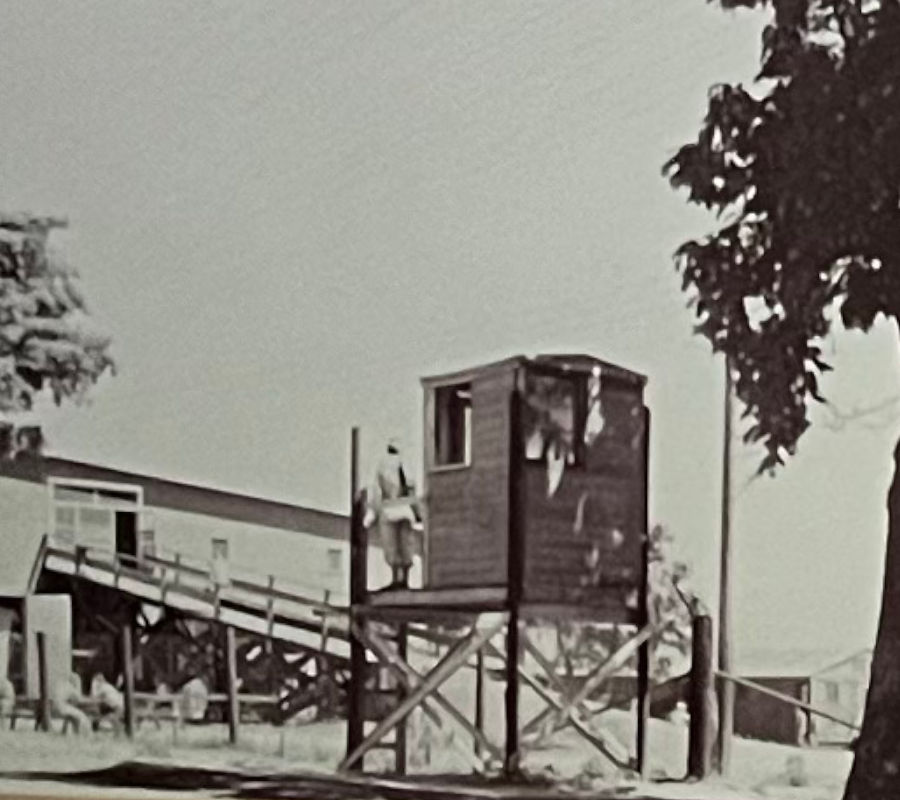 There were few escape attempts: only 2,222, less than 1 percent of prisoners.
One group did try to make a break for it.
Their plan was to steal a car and drive to the coast where they could procure a boat.
They figured it would only be an eight-hour drive in either direction-from Nebraska.
There were few escape attempts: only 2,222, less than 1 percent of prisoners.
One group did try to make a break for it.
Their plan was to steal a car and drive to the coast where they could procure a boat.
They figured it would only be an eight-hour drive in either direction-from Nebraska.
The last POWs and American camp personnel did not leave Fort Robinson until May 1946. Many POWs returned to Germany with money in their pocket, a fluency in English, and educational credits from correspondence classes taken at local universities, which helped the German economy in a small way after the war. That was not the last some of them saw of Nebraska, however. They returned to Germany, but in the ensuing years some emigrated back to the US, becoming American citizens, returning to the plains.
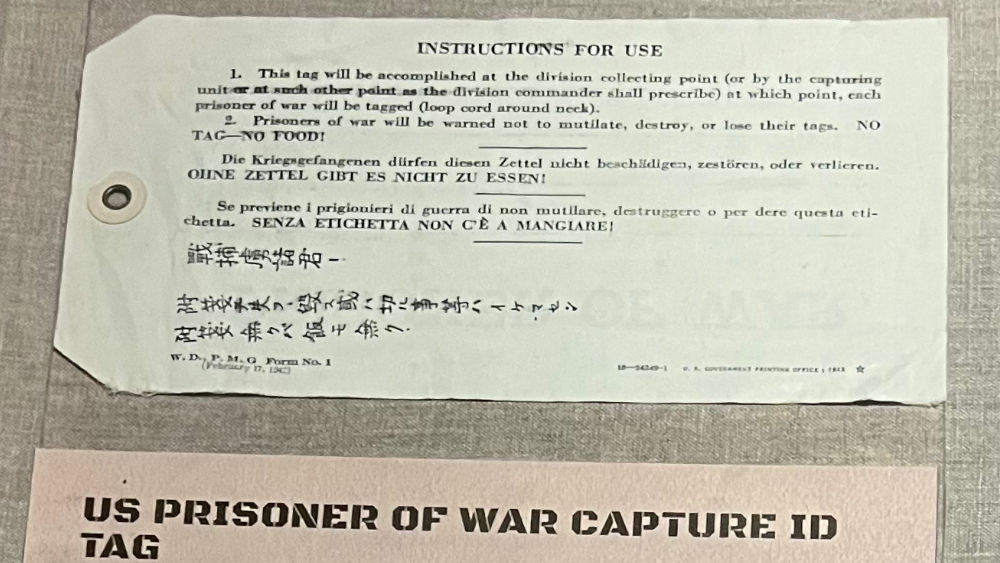
February 1942
The United States War Department's tag for foreign prisoners of war was used when processing prisoners when they were first captured. The tags were hung around the POWs neck. The instructions are printed in English, German, Italian, and Japanese. This one is from the Pacific theater.
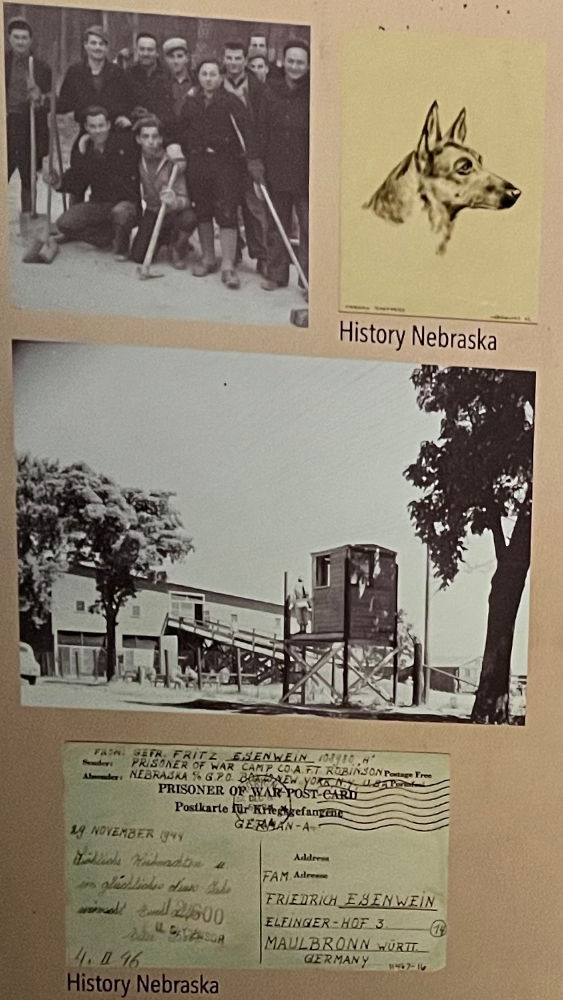
- German Shepherd
Hans F Waecker
This drawing of a German Shepherd was made by 25-year old German POW Hans F. Waecker. He was drafted into the German Air Force in 1940 while at university and was captured in North Africa. After returning to Germany, Waecker emigrated to the United States in 1949 and became a doctor. - German POW Christmas Postcard
November 29, 1944
This Christmas themed POW Postcard is lettered "Stille Nacht, Heilige Nacht," or "Silent Night, Holy Night" in German. It was addressed by prisoner Gefr. Fritz Esenwein to relatives in Maulbronn, Germany, the Friedrich Esenwein family, wishing them Merry Christmas. Like all POW Mail, it has a US Censor stamp.
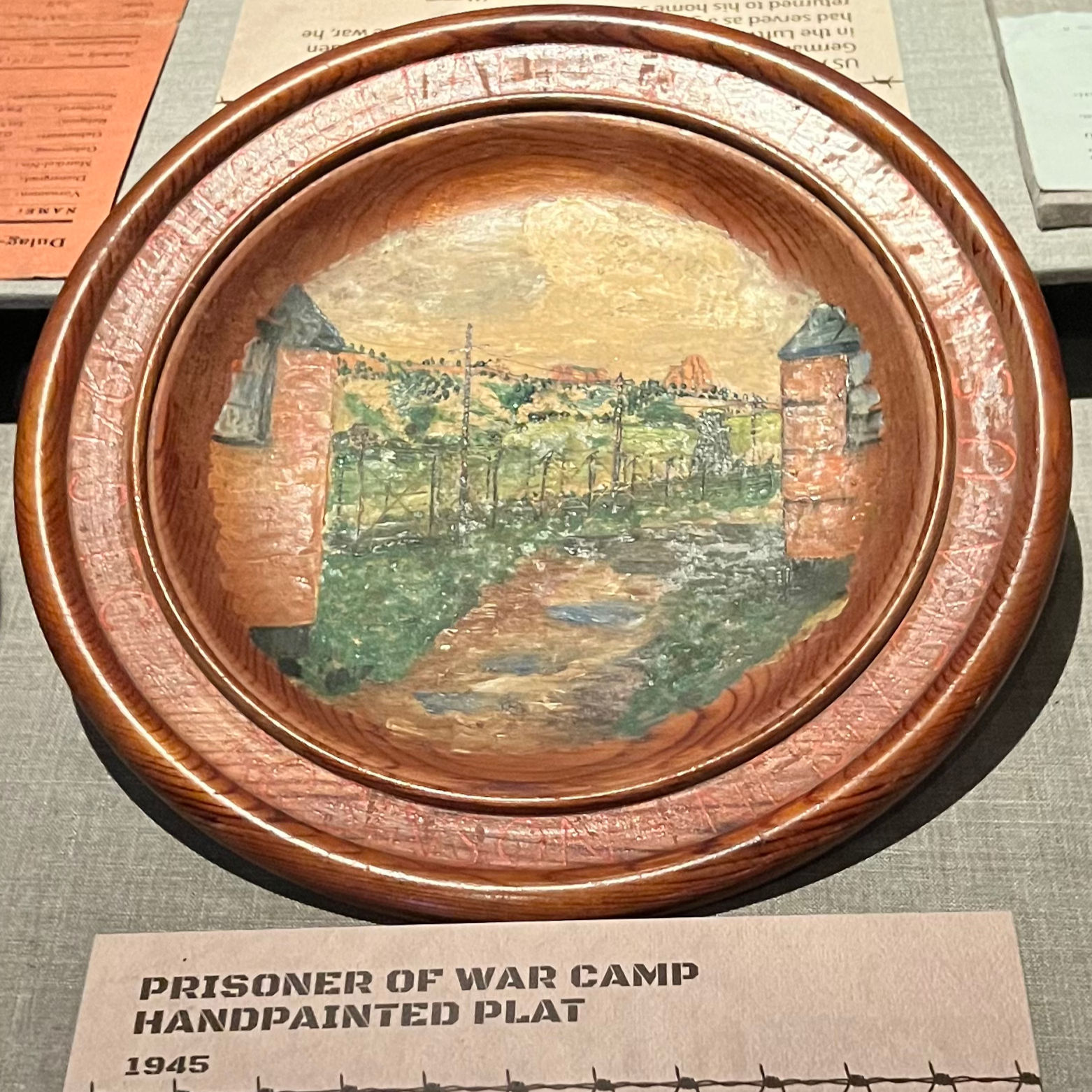
1945
A German POW assigned to Fort Robinson painted this wooden plate with scenes of the "Kriegsgefangenschaft" or "Prisoner of War" Camp.
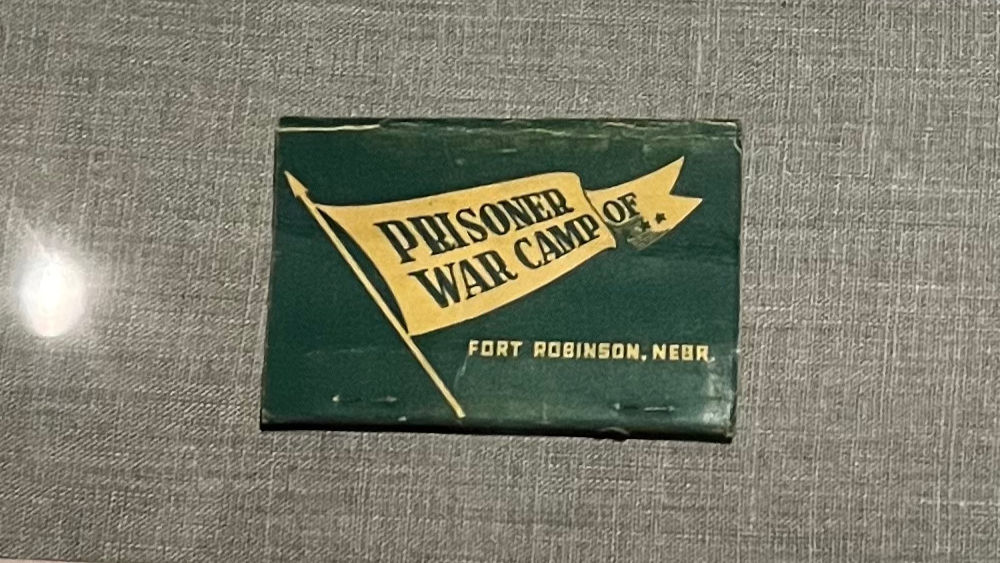
1940-1945
This matchbook was made for the Fort Robinson POW camp by the Corps of Military Police.

1940-1945
This dress cap belonged to a German POW at Fort Robinson.

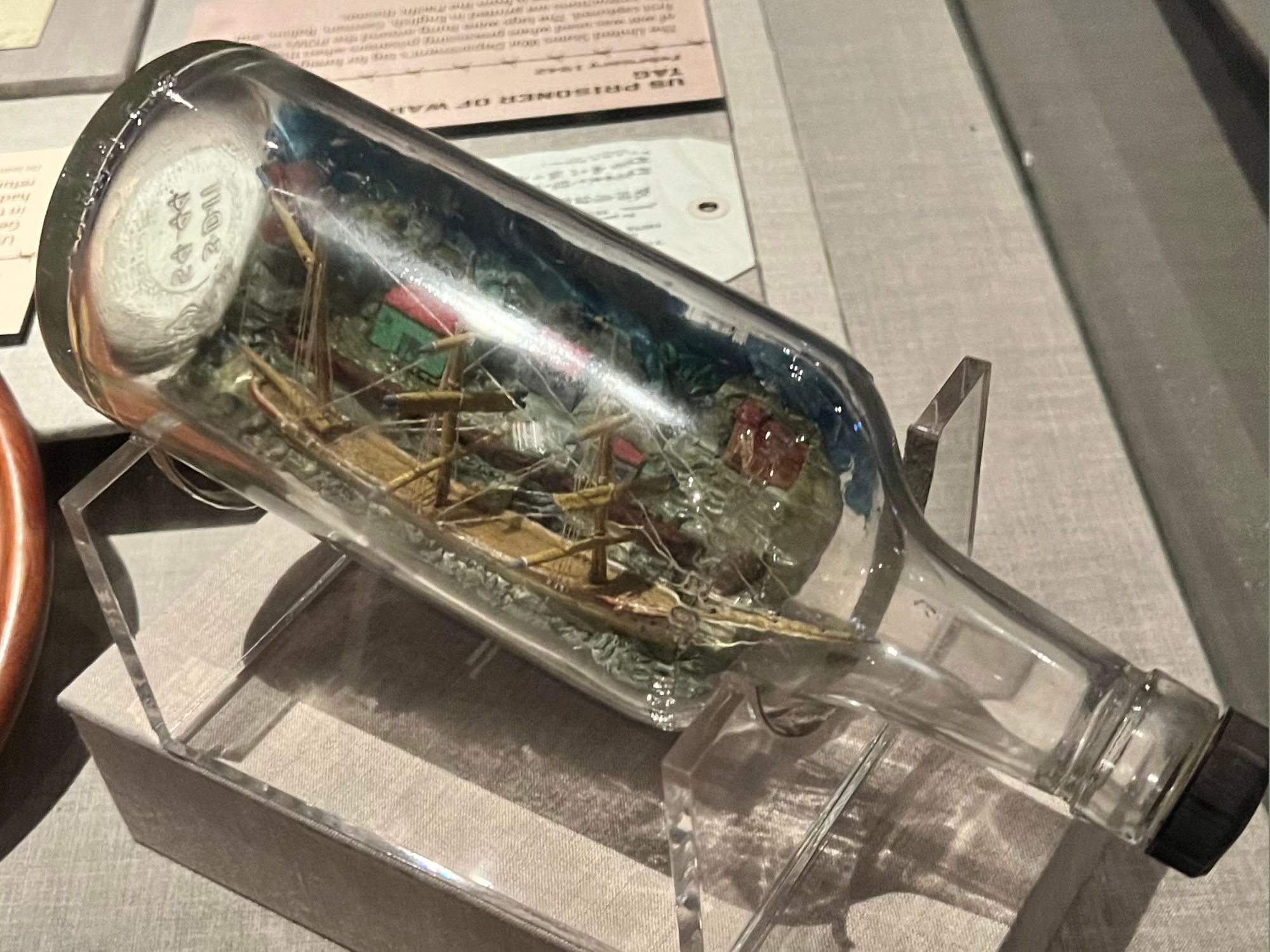
National Park ServiceGerman Enemy Prisoners of War Camp and a US Civil War Battlefield Site
The United States War Department was granted permission by the National Park Service to locate a prisoner of war camp on the battlefield west of the High Water Mark, immediately south of the Home Sweet Home Motel on the Emmitsburg Road in Gettysburg, Pennsylvania. On May 31, 1944, fifty war prisoners from Camp George G. Meade, Maryland, under guard of U. S. Army troops led by Captain L. C. Thomas, began placing poles for the stockade to surround the camp. The fifty German prisoners were housed temporarily in the National Guard Armory on Confederate Avenue. They were joined by an additional one hundred prisoners within three day of the initial arrivals; with another three hundred fifty prisoners arriving one week later. (There were eventually close to five hundred German prisoners of war and approximately ninety guards located at the tent camp on the edge of the borough.) The camp was ready for occupancy by June 20, 1944, and a contingency of four hundred twenty-five prisoners began working in the pea harvest on that date.Any farmer, fruit grower or packing plant company in need of help made application to the local employment service in Gettysburg. Mr. E. A. Crouse was the chairman of the service at that time. It was his responsibility to coordinate the contracts with the local farmers and industries with the military. The original group of prisoners were assigned to fourteen canneries, both fruit and vegetable; three orchards, seventeen farms, one stone quarry and one fertilizer and hide plant. Prisoners were transported and guarded by military police, to the various locations in Littlestown, Biglerville, Hanover, Chambersburg, Middletown and Emmitsburg. The prevailing wages paid by the employers were $1.00 per hour with ten cents per hour credited to the prisoners' accounts. (The United States Government cleared $138,000 on this one camp from June 8 through November 1, 1944.) The prisoners were not paid in cash, but were given coupons which they could spend in the camp post exchange.
After the vegetable season, the prisoners were employed to pick cherries. The government had contracted all of the Pennsylvania orchards and although cherries were gathered by the ton, none was available to civilians as all of the crops were used for the military services. The prisoners ate as they picked and naturally liked this work much better than picking peas or beans.
In the Fall of 1944, Pennsylvania had a bountiful apple crop. The prisoners and the guards would come form the orchards with pockets full of apples. By the time the apple harvest ended, there were prisoner of war work camps all along the eastern seaboard. Eventually as the harvest season ended, the number of prisoners in the tent camp had diminished to two hundred. These men were moved to Camp Sharp, just off Confederate Avenue, on November 15, 1944. The camp on the Emmitsburg Road was strictly a tent camp, so it was necessary to move to warmer quarters with the approaching cold weather. The prisoners were cutting pulp wood and helping to clear underbrush.
WikipediaMembers of the German military were interned as prisoners of war in the United States during World War I and World War II. In all, 425,000 German prisoners lived in 700 camps throughout the United States during World War II.After the United States entered World War II in 1941, the government of the United Kingdom requested American help with housing prisoners of war due to a housing shortage in Britain, asking for the US to take 175,000 prisoners. The United States reluctantly agreed to house them,: 5 although it was not prepared. Its military had only brief experience with a limited POW population in the last world war, and was unprepared for basic logistical considerations such as food, clothing and housing requirements of the prisoners. Almost all German-speaking Americans were engaged overseas directly in combat efforts, and the American government feared the presence of Germans on U.S. soil would create a security problem and raise fear among civilians.
Despite many "wild rumors" about how the Allies treated their prisoners,: 86 some Germans were pleased to be captured by the British or Americans-fear of being captured by the Soviets was widespread-because they disagreed with Nazism or their nation's conduct of the war. The prisoners were usually shipped in Liberty Ships returning home that would otherwise be empty,: 5 with as many as 30,000 arriving per month to New York or Virginia, where they were processed for distribution to camps. While they risked being sunk by their own U-boats on the ocean, good treatment began with the substantial meals served aboard. Upon arriving in America, the comfort of the Pullman cars that carried them to their prison camps amazed the Germans,: 32, 70 as did the country's large size and undamaged prosperity.
Camp life
There were insufficient American guards, especially German speakers. They mostly supervised the German officers and NCOs who strictly maintained discipline. After an American guard who had fought in the Battle of the Bulge killed prisoners in Texas, other guards were given psychiatric tests and removed from duty if necessary.The Germans woke their own men, marched them to and from meals, and prepared them for work; their routine successfully recreated the feel of military discipline for prisoners. Prisoners had friendly interaction with local civilians and sometimes were allowed outside the camps without guards on the honor system. Luxuries such as beer and wine were sometimes available, and hobbies or sports were encouraged. Alex Funke, who served as military chaplain to fellow POWs at Camp Algona, wrote: "We all were positively impressed" by the U.S. and that "We all had been won over to friendly relations with" the U.S. Indeed, unauthorized fraternization between American women and German prisoners was sometimes a problem. Several camps held social receptions with local American girls, and some Germans met their future wives as prisoners.
WIKIPEDIAPrisoner of War Camps
In the United States at the end of World War II, there were prisoner-of-war camps, including 175 Branch Camps serving 511 Area Camps containing over 425,000 prisoners of war (mostly German). The camps were located all over the US, but were mostly in the South, due to the higher expense of heating the barracks in colder areas. Eventually, every state (with the exceptions of Nevada, North Dakota, and Vermont) and Hawaii, then a territory, had at least one POW camp.Some of the camps were designated "segregation camps", where Nazi "true believers" were separated from the rest of the prisoners, whom they terrorized and even killed for being friendly with their American captors.
At its peak in May 1945, a total of 425,871 POWs were held in the US. This included 371,683 Germans, 50,273 Italians, and 3,915 Japanese.
UNITED STATES: POW CAMPS Aliceville Alabama Camp Aliceville Opened in 1943, a segregation camp from 1944. Calhoun County Alabama Fort McClellan Dale County Alabama Camp Rucker Dale County Alabama Fort Rucker Etowah County Alabama Camp Sibert 10 members of Hitler's SS troops were held at the camp. Alabama Camp Opelika Arizona Camp Papago Park Germany's "Great Escape" was from a 200 feet tunnel by 25 prisoners on 24 December 1944. Arizona Camp Pima One of the first segregation camps. Florence Arizona Camp Florence Largest all-new prisoner of war compound ever constructed on American soil. Bassett Arkansas Camp Bassett Dermott, Arkansas Arkansas Camp Dermott Jerome Arkansas Camp Jerome Monticello Arkansas Camp Monticello Pine Bluff Arkansas Grider Field Pine Bluff Arkansas Pine Bluff Arsenal Pulaski County Arkansas Camp Jos. T. Robinson Sebastian County Arkansas Camp Chaffee California Camp Pomona California Camp Stockton California Fort Ord A 120 feet nearly completed escape tunnel was discovered by authorities. Campo California Camp Lockett Auxiliary of Camp Haan in Riverside County, home to last Civil War cavalry unit, Buffalo Soldiers. POW Camp for Italians and Germans Placer County California Camp Flint Riverside County California Camp Haan San Bernardino California Camp Ono Italian camp San Francisco California Camp Angel Island San Luis Obispo California Camp San Luis Obispo Held Italian POWs Santa Barbara County California Camp Cooke Yuba County California Camp Beale El Paso County Colorado Camp Carson Greeley Colorado Camp Greeley Las Animas County Colorado Camp Trinidad A 150 feet electrically lighted escape tunnel was discovered by authorities. This was probably a coal mining tunnel in that Engleville was a coal mining camp where this POW camp is purported to be located. Coal mining was prominent in the late 1870s to the 1950s. A few continued into the early 1970s in Las Animas County where Trinidad is located. Pando-Leadville Colorado Camp Hale Rose Hill Colorado Rocky Mountain Arsenal Windsor Locks Connecticut Bradley Field Now Bradley International Airport Delaware Fort DuPont Delaware Fort Saulsbury Florida Drew Field Now Tampa International Airport and Drew Park. Florida Eglin Army Air Field Clay County Florida Camp Blanding Upwards of 200 German Prisoner of War were moved to Venice Army Air Field in February 1945 from Camp Blanding. Seven German soldiers who had been buried at Camp Blanding, were reinterred on 25 April 1946, at the Fort Benning National Cemetery near Columbus, Ga when the federal government returned Camp Blanding to the Florida National Guard. Milton Florida Naval Air Station Whiting Field Georgia Camp Stewart Georgia Camp Wheeler Georgia Fort Benning Georgia Fort Gordon Bainbridge Georgia Bainbridge Army Airfield Originally an Army Airfield flight training facility. Also housed several hundred German POWs who worked in nearby agricultural farms. Following World War II, the facilities became the Bainbridge State Hospital residential mental health campus until its closure in the 1960s. Fort Oglethorpe Georgia Fort Oglethorpe Thomasville Georgia Camp Thomasville Large German pow camp 2 miles outside of Thomasville. Following World War II, the facilities were taken over by the Veterans Administration with both a hospital and large domiciliary complement. Facilities now serve as an adjunct to the state's mental health program. Hawaii Honouliuli Internment Camp also housed POWs from the Pacific Located on Lake Pend Oreille in Bayview for the duration of World War II Idaho Farragut Naval Training Station The installation housed around 900 Germans, who worked as gardeners and maintenance men around the base and surrounding community. Additionally, Bayview is an unincorporated community; therefore, Farragut Naval Training Station was officially located in Kootenai County. Paul Idaho Camp Rupert Fulton County Illinois Camp Ellis Glenview Illinois Camp Skokie Valley Lake County Illinois Fort Sheridan Sub camps:Camp Pine, Camp Thornton and Camp Skokie Valley, each with 200 POWs. Rockford Illinois Camp Grant Thornton Illinois Camp Thornton Washington Illinois Camp Washington Reinhold Pabel escaped on 9 September 1945 and was recaptured in Chicago in March 1953 Indiana Fort Benjamin Harrison Edinburgh Indiana Camp Atterbury Housed 3,500 Italians and later 10,000 Germans Fort Wayne Indiana Camp Thomas A. Scott Camp Scott held more than 600 German POWs from the Afrika Korps from late 1944 until the camp closed in November 1945. Windfall Indiana Windfall Indiana World War II POW Camp Iowa Camp Storm Lake Iowa Camp Clarinda Algona Iowa Camp Algona Kansas Camp Philips Kansas Fort Leavenworth Kansas Fort Riley Concordia Kansas Camp Concordia Kentucky Camp Breckinridge Kentucky Camp Campbell One of the first three designated camps for anti-Nazis, along with Fort Devens, Massachusetts and Camp McCain. Kentucky Fort Campbell Kentucky Fort Knox Louisiana Camp Eunice Louisiana Camp Gueydan Louisiana Camp Kaplan Louisiana Camp Livingston Louisiana Camp Polk Louisiana Hammond Northshore Regional Airport Louisiana New Orleans Port of Embarkation Bastrop Louisiana Camp Bastrop Branch Camp of Camp Ruston. Kurt Richard Westphal escaped in August 1945 and was recaptured in Hamburg, West Germany in 1954. Forest Hill Louisiana Camp Claiborne Branch Camp of Camp Ruston. Ruston, Louisiana Louisiana Camp Ruston Area Camp with 9 Branch Camps. Capacity for 4800 at main camp. 3 POW compounds, 2 Enlisted, 1 Officer, Hospital Compound, American Compound. Housed diverse groups of POWs ranging from Afrika Corp troops, Italian, Yugoslavian, Chechen, Russian conscripts and others. Later known as an anti-Nazi camp where many intellectuals, artist, writers were among the POWs. The U-505 crew was kept incommunicado in NE compound. Only 1 escapee that was never recaptured who returned to Germany via Mexico. Extensive archive collection of photographs, interviews, art, stone castle, and other memorabilia housed in LA Tech archives provided by Camp Ruston Foundation. Thibodaux Louisiana Thibodaux, Louisiana Housed German POWs from the Afrika Corps after defeat in North Africa. Camp was located in North Thibodaux along Coulon Road. Maine Camp Houlton Maryland Camp Hoffman Close to Fort Lincoln and held over 5,000 soldiers Maryland Camp Somerset Maryland Edgewood Arsenal Maryland Fort Meade Fort Meade housed about 4,000 German and Italian POWs during World War II. Thirty-three German POWs and two Italian POWs are now buried in the post cemetery. The most famous of those buried on the installation is German submariner Werner Henke, who was shot while trying to escape from a secret interrogation center at Fort Hunt, Virginia. Maryland Holabird Signal Depot Cascade Maryland Camp Ritchie German and Italian POW Camp during 1942–1945 housing mostly Africa Corps Officers and Italians enlisted from the Torch Campaign. Camp Ritchie also served as a U.S. Army Training Camp from WWII until it was closed under BRAC during the 1990s to the early 2000s. Almost all of the WWII Camp structures have since been demolished. Also the site of training for "The Ritchie Boys", European refugees trained there to go back into Germany and sabotage the war effort. Massachusetts Camp McKay Constructed for prisoners, later reused for housing after the war Massachusetts Cushing General Hospital Massachusetts Fort Andrews For Italian prisoners Massachusetts Lovell General Hospital Boston Massachusetts Boston Port of Embarkation Boston Massachusetts Fort Strong Boston Harbor Massachusetts Fort Andrews Devens Massachusetts Fort Devens One of the first three designated camps for anti-Nazis, along with Camp Campbell and Camp McCain, Mississippi. Falmouth Massachusetts Camp Edwards Taunton Massachusetts Camp Myles Standish Waltham Massachusetts Waltham Memorial Hospital Westover Massachusetts Westover Field Michigan Camp Dundee Two escaped. Used a railroad box car. Recaptured: Roanoke, Va. Michigan Camp Waterloo Heinz Eschweiler, a 27-year-old German POW, escaped and gave himself up 3 miles north of camp. Capt. Bruce Beiber, commandant at Waterloo, said the prisoner surrendered to Ernest Riemenschneider, who turned him over to state police. The camp housed German Prisoners of War in 1944 and 1945. Michigan Fort Custer In Section B of Fort Custer National Cemetery, there are 26 German graves. Sixteen of the men were killed or died as a result of an accident on 31 October 1945. Alger County Michigan Camp Evelyn Allegan County Michigan Camp Allegan Originally CCC Camp Lakewood built in 1936 AuTrain Michigan Camp AuTrain Freeland Michigan Camp Freeland The current site of the TriCity Airport (MBS) Germfask Michigan Camp Germfask Grant Michigan Camp Grant Formerly located on the south-east corner of East 120th St. and South Walnut Ave. 2.5 miles east of Grant. Prisoners worked on local farms. Sault Ste. Marie Michigan Camp Raco Shlawassee County Michigan Camp Owosso Sidnaw Michigan Camp Sidnaw Upper Peninsula Michigan Camp Pori Minnesota Camp Faribault Minnesota Camp Montgomery Minnesota Camp Owatonna Minnesota Camp Wells New Ulm Minnesota Camp New Ulm Fortuitously located outside a city where many locals still spoke German. The camp buildings are preserved in Flandrau State Park and are available for rent as a group center. St. Charles, Minnesota Minnesota Camp Whitewater Clinton Mississippi Camp Clinton Housed German POWs from the Afrika Korps after their defeat in North Africa Grenada County Mississippi Camp McCain One of the first three designated camps for anti-Nazis, along with Camp Campbell and Fort Devens, Massachusetts. Hattiesburg Mississippi Camp Shelby Panola County Mississippi Camp Como Wilkinson County Mississippi Camp Van Dorn Originally WWII Army infantry training camp. Missouri Camp Crowder Missouri Camp Weingarten Located between Farmington and Ste. Genevieve, Missouri Missouri Fort Leonard Wood Nevada Missouri Camp Clark, Missouri St. Louis Missouri Jefferson Barracks Missoula Montana Fort Missoula 1941-1944: Italian POWs. Nebraska Camp Indianola Nebraska Camp Scottsbluff Nebraska Camp Weeping Water Nebraska Fort Robinson Atlanta Nebraska Camp Atlanta Omaha Nebraska Fort Omaha Coos County New Hampshire Camp Stark New Hampshire's only POW camp. Sited on the abandoned Civilian Conservation Corps camp about 1.6 miles east of the Stark Covered Bridge in Stark, Coos County. New Jersey Fort Dix Harry Girth escaped in June 1946 and surrendered to authorities in New York City in 1953. New Jersey Port Johnson Belle Mead New Jersey Camp Belle Mead Housed primarily Italian POWs. Once Italy surrendered, the Italian POWs were permitted to volunteer for the "Italian Service Unit." This unit provided the POWs with an opportunity to work and earn a wage, as well as preferential treatment. Caven Point, Jersey City New Jersey Jersey City Quartermaster Supply Depot New Mexico Camp Deming Georg Gartner escaped on 21 September 1945, and finally surrendered in 1985. He was the last escapee, having remained at large for 40 years. New Mexico Camp Roswell Located 14 miles (23 km) SE of Roswell. 1942-1946: German POWs. New Mexico Fort Sumner Albuquerque New Mexico Camp Albuquerque Las Cruces New Mexico Camp Las Cruces Werner Paul Lueck escaped in November 1945 and was recaptured in Mexico City in 1954. Lordsburg New Mexico Camp Lordsburg 1942-1945: held Japanese-American internees, and then German and Italian POWs. Santa Fe New Mexico Camp Santa Fe New York Camp Popolopen New York Camp Shanks New York Halloran General Hospital Boonville New York Boonville Jefferson County New York Pine Camp Present Day Fort Drum Niagara County New York Fort Niagara Fort Niagara and Pine Camp (now Fort Drum) maintained several sub or branch camps, including one Geneseo. Rome New York Rome Suffolk County New York Camp Upton Approximately 1,000 Japanese Americans were kept there, under tight security, behind multiple layers of barbed wire fence. Camp Upton was also used to hold Japanese citizens who were in New York City at the time war broke out, including businessman with whom the governments of Japan and the United States negotiated an exchange. Utica New York Utica West Point New York Camp Natural Bridge German camp North Carolina Camp Mackan North Carolina Camp Sutton North Carolina Fort Bragg Butner North Carolina Camp Briner Butner North Carolina Camp Butner Kurt Rossmeisl escaped on 4 August 1945 and surrendered in 1959. Hoffman North Carolina Camp Mackall Ohio Camp Chase Ohio Camp Perry Now home to the CMP Headquarters and Gary Anderson competition center Ohio Patterson Field Marion Ohio Camp Marion Oklahoma Camp Hobart Oklahoma Camp Pauls Valley Oklahoma Camp Pryor Oklahoma Camp Tipton Oklahoma Camp Tishomingo Oklahoma Camp Tonkawa Housed 3000 mostly Germans, taken in North Africa. Site of murder of Johannes Kunze by five fellow German POWs, who were subsequently tried, found guilty, hanged, and buried in the Fort Leavenworth Military Prison Cemetery. Oklahoma Camp Waynoka Oklahoma Fort Reno Alva Oklahoma Camp Alva One of the first segregation camps. Ardmore Army Air Field Oklahoma Camp Gene Autry Atoka Oklahoma Stringtown POW Camp Grady County Oklahoma Camp Chickasha Hickory Oklahoma Camp Horseshoe Ranch Lawton Oklahoma Fort Sill McAlester and Piteburg Oklahoma Camp McAlester http://worldandmilitarynotes.com/pow/camp-mcalester-ok-usa-pow-camp/ Muskogee Oklahoma Camp Gruber Oklahoma City Oklahoma Camp Oklahoma City On site of Will Rogers World Airport. Okmulgee Oklahoma Glennan General Hospital Now the site of Oklahoma State University Institute of Technology Oregon Camp Warner Oregon Camp White Benton County Oregon Camp Adair Pennsylvania Camp Huntsdale Pennsylvania Camp New Cumberland Pennsylvania Camp Reynolds Pennsylvania Olmstead Field Cumberland County Pennsylvania Camp Michaux Located near Pine Grove Furnace State Park. Same commander as Gettysburg Battlefield camp. | Gettysburg Battlefield Pennsylvania camp in McMillan Woods Same commander as Camp Michaux camp. Indiantown Gap Pennsylvania Indiantown Gap Military Reservation Tobyhanna Pennsylvania Tobyhanna Military Reservation Valley Forge Pennsylvania Valley Forge General Hospital Rhode Island Fort Getty Rhode Island Fort Greble Rhode Island Fort Kearny Had program to instill democratic values in Germans based on newspaper Der Ruf (The Call) South Carolina Camp Croft Columbia 34 02'53"N 80 57'10"W South Carolina Fort Jackson All buildings but one have been demolished. The location of the former POW camp is a residential area now. Tennessee Camp Crossville Tennessee Memphis General Depot Lawrenceburg Tennessee Camp Lawrenceburg Sub Camp of Camp Forrest - April 1944 to March 1946 - 331 German Prisoners. Paris Tennessee Camp Tyson POW Camp Tullahoma Tennessee Camp Forrest First attempted escape by two German POWs on 5 November 1942. Texas Camp Brady Texas Camp Hood Texas Camp Huntsville One of the first segregation camps. Texas Camp Maxey Texas Camp McLean Texas Camp Mexia Texas Camp Wolters Texas Fort Bliss Abilene Texas Camp Barkeley Located near what is now Dyess Air Force Base. Bastrop Texas Camp Swift Brown County Texas Camp Bowie See: "News from the Bowie Camp 1943," a written account from Joseph Lehman to a friend. Cooke County Texas Camp Howze Corpus Christi Texas Corpus Christi Naval Air Station Dallas Texas Camp White Rock A former CCC camp it was used for POWs who were with Rommel's Afrika Corps. After the war it became a men's dormitory for Southern Methodist University for the influx of students after the war and now is a Dallas park called Winfrey Point by White Rock Lake. Deaf Smith County Texas Camp Hereford Only for Italians Galveston Texas Fort Crockett Galveston County Texas Camp Wallace Hearne Texas Camp Hearne Johnson County Texas Camp Cleburne Located where the present day Cleburne Conference center is located in the 1500 block of West Henderson(business HWY 67) Kaufman Texas Camp Kaufman: 245, 262 Marfa Texas Fort D.A. Russell Building 98 Palacios Texas Camp Hulen San Antonio Texas Camp Bullis San Antonio Texas Fort Sam Houston Temple Texas McCloskey General Hospital Tyler Texas Camp Fannin Located on the campus of the University of Texas Health Science Center at Tyler. Wharton Texas Camp Wharton Utah Camp Ogden Utah Camp Tooele POW Camp, Co.1, Tooele (original postage) Salina, Utah Utah Camp Salina This camp had a guard fire on and kill several German prisoners. See Utah prisoner of war massacre Virginia Camp Lee Virginia Camp Peary Virginia Fort Curtis Virginia Fort Eustis Virginia Fort Patrick Henry Virginia Hampton Roads Port of Embarkation Virginia Richmond ASF Depot Newport News Virginia Camp Patrick Henry Norfolk Virginia Camp Allen Nottoway County Virginia Camp Pickett Princess Anne County Virginia Camp Ashby Washington Fort Lawton A riot by Negro soldiers took place over preferential treatment given to Italian and German POWs. One Italian POW was lynched, and Leon Jaworski was the military prosecutor. The Italian and one German POW who committed suicide rather than be repatriated are buried just outside the post cemetery boundaries. Washington Fort Lewis Located between Olympia and Tacoma, Washington. West Virginia Camp Dawson Martinsburg West Virginia Newton D. Baker Hospital White Sulphur Springs West Virginia Camp Ashford Altoona Wisconsin Camp Eau Claire Antigo Wisconsin Camp Antigo Appleton Wisconsin Camp Appleton Barron County Wisconsin Camp Barron Bayfield Wisconsin Camp Bayfield Formerly the county courthouse, is now the headquarters of the Apostle Islands National Lakeshore. Beaver Dam Wisconsin Camp Beaver Dam Cambria Wisconsin Camp Cambria Chilton Wisconsin Camp Chilton 300 POWs from Camp McCoy arrived at the Calumet County Fairgrounds in June, 1945. They worked at 8 local canneries until moving to other parts of Wisconsin in August, 1945. Cobb Wisconsin Camp Cobb Columbus Wisconsin Camp Columbus Door County Wisconsin Camp Sturgeon Bay 2,000 German POWs were houses at seven locations on the Door Peninsula, where they worked in the local cherry orchards. Fond du Lac Wisconsin Camp Fond du Lac 300 German POWs were interned at the Fond du Lac County Fairgrounds from June to August 1944 while they harvested peas on local farms and worked in canneries. Fox Lake Wisconsin Camp Fox Lake Fredonia Wisconsin Camp Fredonia 330 German POWs lived in a tent city around the Louis Glunz dance hall and worked on farms and in area canneries during the 1945 harvest. Galesville Wisconsin Camp Galesville Genesee Wisconsin Camp Genesee Germantown Wisconsin Camp Rockfield 500 German POWs were housed in a warehouse and tent city next to the Rockfield Canning Co. plant, where many of them worked as pea packers. Other POWs were transported to work on farms and canneries in neighboring communities. Green Lake Wisconsin Camp Green Lake Hartford Wisconsin Camp Hartford 600 German POWs were interned in the Schwartz Ballroom from October 1944 to January 1946. They were contracted to work on farms and in canneries, mills, and tanneries. Hortonville Wisconsin Camp Hortonville Held German POWs. All buildings have since been demolished, the only structure left standing is the base of one stone pillar where the main gate of the camp stood. Janesville Wisconsin Camp Janesville Jefferson Wisconsin Camp Jefferson Lodi Wisconsin Camp Lodi Markesan Wisconsin Camp Markesan Marshfield Wisconsin Camp Marshfield Merton Wisconsin Camp Keesus Milltown Wisconsin Camp Milltown Milwaukee Wisconsin Camp Billy Mitchell Over 3000 German POWs were interned at Billy Mitchell Field airport (known today as Milwaukee Mitchell International Airport (MKE)) from January 1945 to April 1946. Monroe Wisconsin Camp McCoy Japanese and German POWs; Japanese, Italian, and German internees; now Fort McCoy Oakfield Wisconsin Camp Oakfield Oneida County Wisconsin Camp Rhinelander Plymouth Wisconsin Camp Plymouth Reedsburg Wisconsin Camp Reedsburg Ripon Wisconsin Camp Ripon Sturtevant Wisconsin Camp Sturtevant Waterloo Wisconsin Camp Waterloo Waupun Wisconsin Camp Waupun Winooski Wisconsin Camp Sheboygan From July to December 1945, 450 German POWs were housed in the Sheboygan County Asylum, which was built in 1878 and abandoned in 1940 when a new facility was completed. Wisconsin Rapids Wisconsin Camp Wisconsin Rapids 200 German POWs were interned at the Tri-City Airport (now known as South Wood County Airport) from July to November 1945. Wyoming Fort F.E. Warren Douglas Wyoming Camp Douglas WIKIPEDIA







